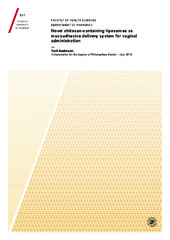| dc.contributor.advisor | Škalko-Basnet, Nataša | |
| dc.contributor.author | Andersen, Toril | |
| dc.date.accessioned | 2015-10-16T14:22:22Z | |
| dc.date.available | 2015-10-16T14:22:22Z | |
| dc.date.issued | 2015-10-02 | |
| dc.description.abstract | Treatment of vaginal infections remains unsuccessful due to recurrent infections and limited patient compliance. Current therapies are unable to penetrate bacterial and fungal biofilms, allowing the survival of microorganisms, which often leads to new infections. Local administration of drug is able to provide a higher drug concentration at the vaginal site; enabling the administration of lower drug doses and reduced administration frequency that again decreases the risk of adverse reactions. A successful local treatment should assure a sufficient amount of a drug at the vaginal site for a sufficient period of time. This can be achieved by a mucoadhesive drug delivery system.
Coating of nanopharmaceuticals with mucoadhesive polymers has been proposed as a mean to assure longer residence time at the vaginal site. However, conventional coating techniques may reduce the concentration of the loaded drug due to the subsequent coating of preformed liposomes and are in addition time consuming. The aim of this work was the development of novel mucoadhesive polymer-containing liposomes that would allow for a straightforward and simple one-pot preparation method. Chitosan was chosen as a promising polymer based on its known mucoadhesiveness, biological activity and general safety profile.
The resulting chitosan-containing liposomes were characterized for their size distribution, zeta potential, entrapment efficiency and in vitro release of a drug (metronidazole) and model substances (FITC-dextrans of varying molecular weights). The characterization of surface-available chitosan in the novel system has shown that the system contains both chitosan as an outer coating as well as embedded within the liposomes, and the mucoadhesive effect of the surface-available chitosan has further been confirmed. The system provides sustained release of entrapped drug or model substances, and is expected to assure sufficiently high drug concentrations at vaginal site. The chitosan-containing liposomes exhibited a potent ability to inhibit the growth of Candida albicans independently of the presence of loaded drug. This could be utilized in the treatment of vaginal infections of complicated natures, such as mixed bacterial and fungal infections. | en_US |
| dc.description.doctoraltype | ph.d. | en_US |
| dc.description.popularabstract | Vaginale infeksjoner er den vanligste grunnen til at kvinner oppsøker lege, de fleste kvinner vil igjennomgå minst et tilfelle i løpet av livet. Dessverre er behandling av vaginale infeksjoner ikke god nok og ofte forekommer gjentatte infeksjoner som følge av gjenlevende mikroorganismer. Ved å behandle disse infeksjonene lokalt kan man få bedre effekt, lavere dosering og mindre risiko for bivirkninger. Målet i dette prosjektet have vært å utvikle en type nanopartikler, kalt Chitosomer, som er dekket av en film av et stoff heter chitosan. Dette er et molekyl som består av lange kjeder av sukkermolekyler og det finnes naturlig i skall fra reker og krabber. Chitosan er i stand til å drepe bakterier og sopp som er involvert i vaginale infeksjoner, det er også trygt å bruke. I dette prosjektet har vi vist av Chitosomene er i stand til å drepe Candida albicans, som gir soppinfeksjoner, vi har også vist at Chitosomene kan kombineres med et antibiotika og dermed gi to angrepspunkt. | en_US |
| dc.description.sponsorship | University of Tromsø and Umeå University | en_US |
| dc.description | Paper III of this thesis is not available in Munin.<br>Chitosomes: novel chitosan-containing liposomes with antifungal activity against Candida albicans. Toril Andersen, Ekaterina Mishchenko, Gøril Eide Flaten, Johanna U. Ericson Sollid, Sofia Mattsson, Ingunn Tho, Nataša Škalko-Basnet. (Manuscript) | en_US |
| dc.identifier.uri | https://hdl.handle.net/10037/8219 | |
| dc.identifier.urn | URN:NBN:no-uit_munin_7800 | |
| dc.language.iso | eng | en_US |
| dc.publisher | UiT The Arctic University of Norway | en_US |
| dc.publisher | UiT Norges arktiske universitet | en_US |
| dc.rights.accessRights | openAccess | |
| dc.rights.holder | Copyright 2015 The Author(s) | |
| dc.rights.uri | https://creativecommons.org/licenses/by-nc-sa/3.0 | en_US |
| dc.rights | Attribution-NonCommercial-ShareAlike 3.0 Unported (CC BY-NC-SA 3.0) | en_US |
| dc.subject | Metronidazole | en_US |
| dc.subject | VDP::Medisinske Fag: 700::Basale medisinske, odontologiske og veterinærmedisinske fag: 710::Biofarmasi: 736 | en_US |
| dc.subject | Chitosan | en_US |
| dc.subject | Liposomes | en_US |
| dc.subject | Mucoadhesion | en_US |
| dc.subject | Vaginal therapy | en_US |
| dc.subject | Antifungal | en_US |
| dc.subject | VDP::Medical disciplines: 700::Basic medical, dental and veterinary science disciplines: 710::Biopharmacy: 736 | en_US |
| dc.title | Novel chitosan-containing liposomes as mucoadhesive delivery system for vaginal administration | en_US |
| dc.type | Doctoral thesis | en_US |
| dc.type | Doktorgradsavhandling | en_US |


 English
English norsk
norsk


